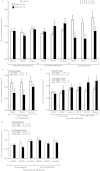Influence of age, gender, and race on nitric oxide release over acupuncture points-meridians
- PMID: 26621821
- PMCID: PMC4664911
- DOI: 10.1038/srep17547
Influence of age, gender, and race on nitric oxide release over acupuncture points-meridians
Abstract
This study examined the influence of age, gender and race on nitric oxide (NO) release over acupuncture points, meridian without acupoint, and non-meridian regions of the Pericardium (PC) and Bladder (BL) meridian as well as aging on LU meridian in 61 healthy subjects. Biocapture tubes were attached to the skin surface, and total nitrite and nitrate was biocaptured and quantified using chemiluminescence. In elder ages compared to adults, NO levels over the ventral forearm were significantly decreased over LU on radial regions but not altered over PC on medial regions. Conversely, NO content was elevated over BL regions only in overweight/obesity of elder ages. NO levels over PC regions were marginally elevated in overweight/obese males compared to females but did not alter between races. These results suggest a selective reduction of NO release over LU meridian with aging, which is consistent with a progressive decline in lung function and increase in chronic respiratory disease in elder ages. Increased NO levels along the BL meridian in older obese subjects may reflect a modified NO level along somatic-bladder pathway for counteracting bladder dysfunctions with aging. Both of them support somatic-organ connections in the meridian system associated with potential pathophysiological changes with aging.
Figures




Similar articles
-
Transcutaneous Electrical Stimulation Increased Nitric Oxide-Cyclic GMP Release Biocaptured Over Skin Surface of Pericardium Meridian and Acupuncture Points in Humans.Acupunct Electrother Res. 2015;40(2):73-86. doi: 10.3727/036012915x14381285982840. Acupunct Electrother Res. 2015. PMID: 26369251 Free PMC article. Clinical Trial.
-
Changes in nitric oxide, cGMP, and nitrotyrosine concentrations over skin along the meridians in obese subjects.Obesity (Silver Spring). 2011 Aug;19(8):1560-7. doi: 10.1038/oby.2010.294. Epub 2010 Dec 9. Obesity (Silver Spring). 2011. PMID: 21151015 Free PMC article.
-
Enhanced nitric oxide concentrations and expression of nitric oxide synthase in acupuncture points/meridians.J Altern Complement Med. 2003 Apr;9(2):207-15. doi: 10.1089/10755530360623329. J Altern Complement Med. 2003. PMID: 12804074
-
[Effect of nitric oxide on noradrenergic function and skin electric resistance of acupoints and meridians].Zhen Ci Yan Jiu. 2008 Jun;33(3):213-6. Zhen Ci Yan Jiu. 2008. PMID: 18807729 Review. Chinese.
-
[Discussion on the regular of acupoint selection of acupuncture and moxibustion for lumbar disc herniation during recent 10 years].Zhongguo Zhen Jiu. 2013 Jul;33(7):668-72. Zhongguo Zhen Jiu. 2013. PMID: 24032212 Review. Chinese.
Cited by
-
Acute Physiological and Psychological Effects of Qigong Exercise in Older Practitioners.Evid Based Complement Alternat Med. 2018 Apr 2;2018:4960978. doi: 10.1155/2018/4960978. eCollection 2018. Evid Based Complement Alternat Med. 2018. PMID: 29805467 Free PMC article.
-
Low Electrical Resistance Properties of Acupoints: Roles of NOergic Signaling Molecules and Neuropeptides in Skin Electrical Conductance.Chin J Integr Med. 2021 Aug;27(8):563-569. doi: 10.1007/s11655-021-3318-5. Epub 2021 Jul 28. Chin J Integr Med. 2021. PMID: 34319572 Free PMC article.
-
The effects of two different doses of ultraviolet-A light exposure on nitric oxide metabolites and cardiorespiratory outcomes.Eur J Appl Physiol. 2018 May;118(5):1043-1052. doi: 10.1007/s00421-018-3835-x. Epub 2018 Mar 7. Eur J Appl Physiol. 2018. PMID: 29516257 Free PMC article.
-
Traditional, Complementary and Alternative Medicines in the Treatment of Ejaculatory Disorders: A Systematic Review.Medicina (Kaunas). 2023 Sep 6;59(9):1607. doi: 10.3390/medicina59091607. Medicina (Kaunas). 2023. PMID: 37763726 Free PMC article.
-
Mechanism of traditional Chinese medicine in treating overactive bladder.Int Urol Nephrol. 2023 Mar;55(3):489-501. doi: 10.1007/s11255-022-03434-8. Epub 2022 Dec 7. Int Urol Nephrol. 2023. PMID: 36479677 Free PMC article. Review.
References
-
- Chan S. H. What is being stimulated in acupuncture: evaluation of the existence of a specific substrate. Neurosci. Biobehav. Rev. 8 25–33 (1984). - PubMed
-
- Beijing College of Traditional Chinese Medicine, Shanghai College of Traditional Chinese Medicine, Nanjing College of Traditional Chinese Medicine & The Acupuncture Institute of the Academy of Traditional Chinese Medicine. Essentials of Chinese Acupuncture. Foreign Languages Press, Beijing, China, 1980.
-
- Luciani R. J. Direct observation and photography of electroconductive points on human skin. Am. J. Acup. 6 311–317 (1978).
-
- Wang Z. T., Wu S. L., Cao Y. C., Zhu Z. X. & Xu R. M. Morphological study on the low impedance line along channel. Acup. Res. 1 82–85 (1987). - PubMed
-
- Tiberiu R., Gheorghe G. & Popescu I. Do meridians of acupuncture exist? A radioactive tracer study of the Bladder Meridian. Am. J. Acupuncture 9 251–256 (1981).
Publication types
MeSH terms
Substances
Grants and funding
LinkOut - more resources
Full Text Sources
Other Literature Sources
Medical
Miscellaneous

